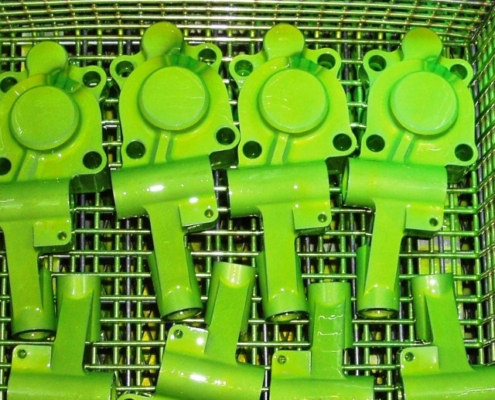Dye Penetrant Inspection
We offer a comprehensive, non-destructive, Dye Penetrant Inspection (DPI) testing service.
This form of testing is also sometimes called Liquid Penetrant Inspection (LPI) and is a widely applied and low-cost inspection method used to locate surface-breaking defects in all non-porous materials (metals, plastics, or ceramics).
The penetrant may be applied to all non-ferrous materials, but for inspection of ferrous components magnetic-particle inspection is preferred for its subsurface detection capability. DPI is used to detect casting and forging defects, cracks, and leaks in new products, and fatigue cracks on in-service components. Special applications are for the aerospace, defence and automotive industries.
Common applications:
- Cracking of welded joints
- Areas identified as being susceptible to environmental cracking
- Machined surfaces by Fluorescent DPI for fine flaws and defects
Below are the main steps of Dye Penetrant Inspection
The testing surface is cleaned to remove any paint, oil, dirt, grease or any loose materials that could either stop penetrant entering a defect, or cause false indications, the end goal is a clean surface where any defects present are open to the surface, dry, and free of contamination.
Pre-cleaning
The testing surface is cleaned to remove any paint, oil, dirt, grease or any loose materials that could either stop penetrant entering a defect, or cause false indications, the end goal is a clean surface where any defects present are open to the surface, dry, and free of contamination.
Application of the penetrant
The penetrant is applied to the surface of the item being tested, it is then given time to soak into any defects (generally 10 to 30 minutes). The time mainly depends upon which penetrant is being used, material being tested and the size of defects sought. Smaller flaws require a longer penetration time.
Excess penetrant removal
The excess penetrant is then removed from the surface. Depending on the type of penetrant being used, whether it is water-washable, solvent-removable, lipophilic post-emulsifiable, or hydrophilic post-emulsifiable this will control the type of penetrant used. This process must be performed under controlled conditions so that all penetrant on the surface is removed, but the penetrants trapped in real defects remain in place.
Application of developer
Once the excess penetrant has been removed a white developer is applied to the item. The developer should form a semi-transparent, even coating on the surface of the test area. The developer will then draw penetrant from defects out onto the surface to form a visible indication.
Inspection
Our engineer will use visible light with adequate intensity for visible dye penetrant and ultraviolet (UV-A) radiation of adequate intensity, as well as low ambient light levels for fluorescent penetrant examinations. Inspection of the test surface normally takes place after a 10 minute development time.

